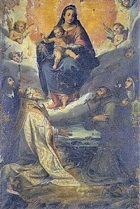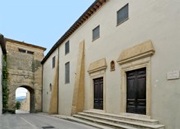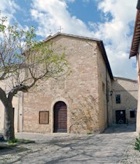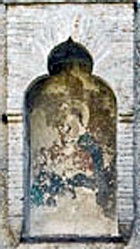

The most important nunnery in Montefalco is Santa Chiara, which has its own page in this website.
San Clemente (1577)
The first church on this site gave its name to the surrounding area. It passed to a community of female Franciscan Tertiaries in 1516 and they restored it in 1522. However, they abandoned it soon after, possibly because of the depredations of Imperial troops after the sack of Rome in 1527.
A community of Poor Clares, who had moved from Santa Caterina, Foligno to San Rocco in 1536, moved again to this site, inside the town walls, in 1577. They effectively rebuilt the church and adjoining nunnery.
The nunnery was suppressed in the Napoleonic period and the Commune adapted its buildings to house a hospital. When this was moved to the nearby ex-convent of San Francesco in 1860, the space was adapted again to serve as a prison.
The nunnery was demolished in 1979, and the ex-church was gravely damaged when the level of its pavement was raised substantially.
Art from the Church
Madonna and Child with saints (1602)

The composition of the panel is based on that of Raphael’s Madonna di Foligno (1511-2), which was at this time on the high altar of Sant’ Anna, the church of a Franciscan nunnery in Foligno.
St Agnes (17th century)
This altarpiece is now in Sant’ Agostino.
San Leonardo (13th century)

A church here dedicated as Santa Maria del Paradiso and an adjoining hospice for the poor dedicated as San Leonardo were first documented in 1205. The church is now more usually also known as San Leonardo.
In 1492, fourteen nuns moved here from the nunnery of Santa Chiara and adopted the Franciscan (as opposed to their original and more relaxed Augustinian) rule. They adapted the hospice as a nunnery.
In 1508, Sister Felice de Stefano da Osimo and a few other nuns from San Leonardo moved to a new nunnery formed at San Procolo, Terni. Sister Felice became the first abbess.
Church
Two portals in the front wall of the nunnery belong to its church. The interior of the church was re-modelled in 1789, at which point its earlier frescoes were largely destroyed. It is not open to the public.
Madonna and Child (1479)
This detached fresco on the altar on the left is all that remains of what was an extensive and documented series of frescoes by Jacopo di Vinciolo.
Madonna and Child enthroned with angels and saints (1515)
This signed altarpiece on the high altar, which is dated by inscription, is the masterpiece of Francesco Melanzio. It depicts the Mother and Child with the kneeling SS Jerome and Francis and a number of other saints.
Santa Maria Maddalena (ca. 1269)

This church originally belonged to a community of female Franciscan tertiaries. It is documented in a Bull (1329) of Pope John XXII, when it had recently adopted the Rule of St Clare of Assisi.
The church was extended in 1461, as recorded by an inscription on the right wall, which was originally its facade. The church was documented in 1511, when the sisters apparently followed the Augustinian Rule.
The church had to be effectively rebuilt in 1726, when its walls threatened to collapse. It subsequently became known as the Chiesa dell’ Addolorata. It was restored in 1978 [but is no longer in use ??].
Exterior

Interior
Frescoes (15th century)
These frescoes on the left wall, which are attributed to Cristoforo di Jacopo da Foligno, depict:
-
✴two saints; and
-
✴the Crucifixion.
St Nicholas of Tolentino (1515)
This fresco fragment on the right wall, which is attributed to Francesco Melanzio and dated by inscription, was originally part of a larger fresco.
Madonna dell' Addolorata (1751)
This statue is on the high altar.
Art from the Church
Assumption of St Mary Magdalene (ca. 1732)






